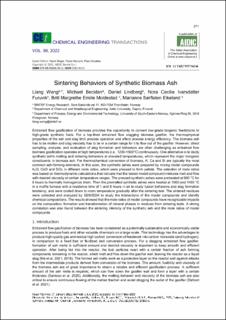| dc.contributor.author | Wang, Liang | |
| dc.contributor.author | Becidan, Michael | |
| dc.contributor.author | Lindberg, Daniel | |
| dc.contributor.author | Furuvik, Nora Cecilie Ivarsdatter | |
| dc.contributor.author | Moldestad, Britt Margrethe Emilie | |
| dc.contributor.author | Eikeland, Marianne Sørflaten | |
| dc.date.accessioned | 2023-02-22T11:39:24Z | |
| dc.date.available | 2023-02-22T11:39:24Z | |
| dc.date.created | 2022-12-16T13:05:47Z | |
| dc.date.issued | 2022 | |
| dc.identifier.citation | Chemical Engineering Transactions. 2022, 96 271-276. | en_US |
| dc.identifier.issn | 1974-9791 | |
| dc.identifier.uri | https://hdl.handle.net/11250/3053209 | |
| dc.description.abstract | Entrained flow gasification of biomass provides the opportunity to convert low-grade biogenic feedstocks to high-grade synthetic fuels. For a top-fired entrained flow slagging biomass gasifier, the thermophysical properties of the ash and slag limit process operation and affect process energy efficiency. The biomass ash has to be molten and slag viscosity has to be in a certain range for it to flow out of the gasifier. However, direct sampling, analysis, and evaluation of slag formation and behaviors are often challenging as entrained flow biomass gasification operates at high temperatures (i.e., 1200-1500°C) continuously. One alternative is to study synthetic ash's melting and sintering behaviors at elevated temperatures, which represent the major inorganic constituents in biomass ash. For thermochemical conversion of biomass, K, Ca and Si are typically the most common ash-forming elements. In this work, the synthetic ashes were prepared by mixing model compounds K2O, CaO and SiO2 in different mole ratios, which were pressed to form pellets. The selection of mole ratios was based on thermodynamic calculations that indicate that the tested model compound mixtures melt and flow with desired viscosity at certain temperature ranges. The pressed synthetic ashes were preheated at 900 °C for 8 hours to thermally homogenize them. Then the premelted synthetic ashes were heated at 1000 and 1400 °C in a muffle furnace with a residence time of 1 and 8 hours in air to study fusion behaviors and slag formation tendency, and were cooled down to room temperature gradually after the sintering test. The sintered residues were collected and analyzed by SEM/EDX to study the interactions of the model compounds and identify chemical compositions. The results showed that the mole ratios of model compounds have recognizable impacts on the composition, formation and transformation of mineral phases in residues from sintering tests. A strong correlation was also found between the sintering intensity of the synthetic ash and the mole ratios of model compounds. | en_US |
| dc.language.iso | eng | en_US |
| dc.publisher | AIDIC | en_US |
| dc.title | Sintering Behaviors of Synthetic Biomass Ash | en_US |
| dc.title.alternative | Sintering Behaviors of Synthetic Biomass Ash | en_US |
| dc.type | Peer reviewed | en_US |
| dc.type | Journal article | en_US |
| dc.description.version | publishedVersion | en_US |
| dc.source.pagenumber | 271-276 | en_US |
| dc.source.volume | 96 | en_US |
| dc.source.journal | Chemical Engineering Transactions | en_US |
| dc.identifier.doi | 10.3303/CET2296046 | |
| dc.identifier.cristin | 2094366 | |
| dc.relation.project | Norges forskningsråd: 280892 | en_US |
| dc.relation.project | Norges forskningsråd: 257622 | en_US |
| cristin.ispublished | true | |
| cristin.fulltext | original | |
| cristin.qualitycode | 1 | |
